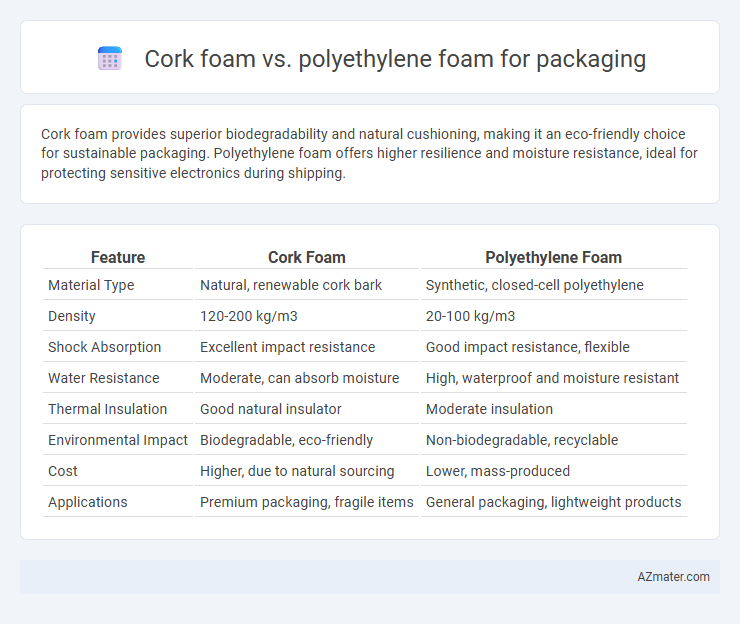Cork foam provides superior biodegradability and natural cushioning, making it an eco-friendly choice for sustainable packaging. Polyethylene foam offers higher resilience and moisture resistance, ideal for protecting sensitive electronics during shipping.
Table of Comparison
| Feature | Cork Foam | Polyethylene Foam |
|---|---|---|
| Material Type | Natural, renewable cork bark | Synthetic, closed-cell polyethylene |
| Density | 120-200 kg/m3 | 20-100 kg/m3 |
| Shock Absorption | Excellent impact resistance | Good impact resistance, flexible |
| Water Resistance | Moderate, can absorb moisture | High, waterproof and moisture resistant |
| Thermal Insulation | Good natural insulator | Moderate insulation |
| Environmental Impact | Biodegradable, eco-friendly | Non-biodegradable, recyclable |
| Cost | Higher, due to natural sourcing | Lower, mass-produced |
| Applications | Premium packaging, fragile items | General packaging, lightweight products |
Introduction to Cork Foam and Polyethylene Foam
Cork foam is a natural, lightweight, and sustainable material known for its excellent shock absorption and thermal insulation properties, making it ideal for environmentally friendly packaging solutions. Polyethylene foam, a synthetic polymer-based material, offers superior flexibility, moisture resistance, and cushioning, widely used for protecting delicate items during shipping. Both materials serve distinct packaging needs, with cork foam favored for eco-conscious applications and polyethylene foam preferred for its durability and versatility.
Key Material Properties Compared
Cork foam offers excellent compressive strength, natural elasticity, and superior thermal insulation, making it ideal for protecting delicate items during transit. Polyethylene foam is characterized by its lightweight structure, high impact resistance, and superior moisture absorption, providing durable cushioning for various packaging applications. Comparing key material properties reveals cork foam's biodegradability and sustainability advantages, while polyethylene foam excels in chemical resistance and versatility in shaping.
Cushioning Performance and Shock Absorption
Cork foam offers superior cushioning performance due to its natural cellular structure, providing excellent shock absorption and resilience under repeated impacts, making it ideal for delicate packaging. Polyethylene foam is lightweight and provides consistent shock absorption with high energy return, ensuring effective protection against vibrations and drops in various shipping conditions. Both materials vary in density and compression resistance, with cork foam excelling in eco-friendly packaging solutions and polyethylene foam favored for cost-effective, versatile cushioning.
Sustainability and Environmental Impact
Cork foam offers superior sustainability compared to polyethylene foam due to its biodegradability, renewable sourcing from cork oak trees, and lower carbon footprint during production. Polyethylene foam, derived from non-renewable petroleum resources, poses environmental challenges because of its persistence in landfills and difficulty in recycling. Choosing cork foam for packaging aligns with eco-friendly practices by reducing plastic waste and supporting circular economy principles.
Cost Efficiency and Economic Considerations
Cork foam offers superior cost efficiency in packaging due to its natural renewable source and lower processing expenses compared to polyethylene foam, which relies on petrochemical raw materials and higher manufacturing costs. Economic considerations favor cork foam for sustainable packaging solutions as it reduces waste disposal fees and promotes a circular economy through biodegradability. Polyethylene foam may incur additional expenses related to environmental compliance and recycling challenges, impacting the overall cost-effectiveness in long-term packaging strategies.
Durability and Longevity in Packaging
Cork foam offers superior durability and longevity in packaging due to its natural resilience, ability to withstand repeated compression, and resistance to moisture and chemicals, ensuring prolonged protection of fragile items. Polyethylene foam provides excellent shock absorption and water resistance but tends to degrade faster under UV exposure and heavy mechanical stress, leading to reduced lifespan in comparison. When prioritizing long-term packaging solutions, cork foam is often favored for its sustainable durability and extended service life.
Weight and Transport Implications
Cork foam offers a lightweight packaging solution with a density typically around 120-200 kg/m3, significantly reducing shipping weight compared to traditional polyethylene foam, which ranges from 30 to 100 kg/m3 but often requires thicker layers for equivalent cushioning. The lower density and natural compressibility of cork foam enhance transport efficiency by minimizing package weight and volume, leading to reduced fuel consumption and lower carbon emissions during transit. Polyethylene foam, while durable and moisture-resistant, can increase overall shipping costs due to its bulkier nature and heavier packaging, making cork foam a more sustainable choice for lightweight, eco-friendly transportation.
Customization and Versatility
Cork foam offers exceptional customization options with its ability to be easily cut, shaped, and molded to fit unique product dimensions, making it ideal for delicate or irregularly shaped items in packaging applications. Polyethylene foam provides superior versatility by offering various densities and thicknesses, allowing for tailored cushioning and impact absorption in diverse packaging needs. Both materials support customization, but cork foam excels in eco-friendly customization while polyethylene foam leads in adaptable protective performance.
Safety and Chemical Resistance
Cork foam offers excellent natural safety attributes due to its non-toxic, hypoallergenic properties, making it ideal for sensitive packaging needs. Polyethylene foam excels in chemical resistance, effectively protecting contents from oils, solvents, and moisture exposure. Both materials provide cushioning, but polyethylene foam's superior resistance to aggressive chemicals makes it preferred in industrial applications requiring robust chemical protection.
Best Applications: Choosing the Right Foam for Packaging
Cork foam offers excellent cushioning and shock absorption, making it ideal for packaging fragile items such as electronics and glassware, while its natural, sustainable properties appeal to eco-conscious brands. Polyethylene foam excels in impact resistance, moisture barrier capabilities, and flexibility, which suits packaging for heavy machinery, automotive parts, and water-sensitive products. Selecting the right foam depends on factors like product fragility, environmental exposure, and sustainability goals to optimize protection and cost-efficiency in packaging solutions.

Infographic: Cork foam vs Polyethylene foam for Packaging
 azmater.com
azmater.com